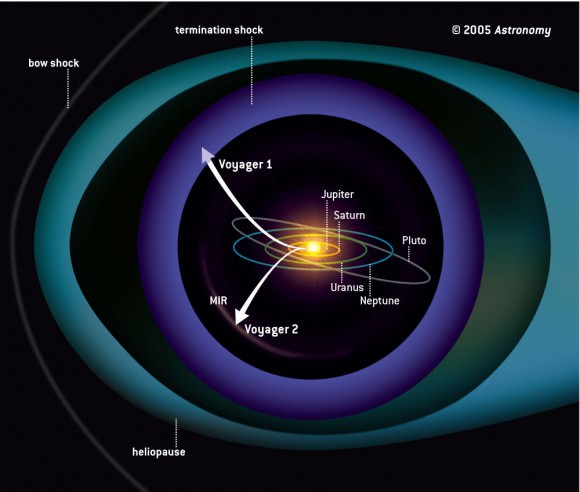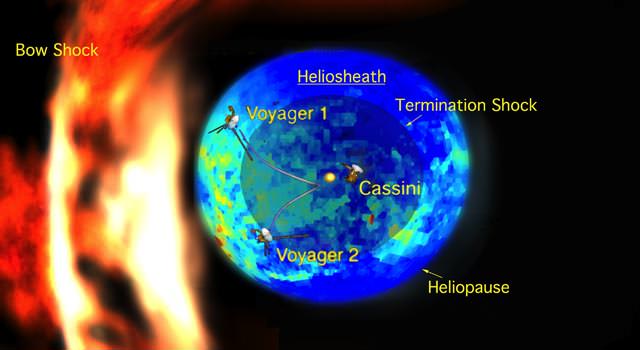Though the Cassini mission has focused intently on scientific exploration of Saturn and its moons, data taken by the spacecraft has significantly changed the way astronomers think about the shape of our Solar System. As the Sun and planets travel through space, the bubble in which they reside has been thought to resemble a comet, with a long tail and blunt nose. Recent data from Cassini combined with that of other instruments, shows that the local intertstellar magnetic field shapes the heliosphere differently.
The Solar System resides in a bubble in the interstellar medium – called the “heliosphere” – which is created by the solar wind. The shape carved out of the interstellar dust by the solar wind has been thought for the past 50 years to resemble a comet, with a long tail and blunted nose shape, caused by the motion of the Solar System through the dust.
Data taken by Cassini’s Magnetospheric Imaging Instrument (MIMI) and the Interstellar Boundary Explorer (IBEX) shows that there is more to the forces that cause the shape than previously thought, and that the shape of the heliosphere more closely resembles a bubble.
The shape of the heliosphere was previously thought to have been carved out solely by the interaction of the solar wind particles with the interstellar medium, the resulting “drag” creating a wispy tail. The new data suggests, however, that the interstellar magnetic field slips around the heliosphere and the outer shell, called the heliosheath, leaving the spherical shape of the heliosphere intact. Below is an image representing what the heliosphere was thought to look like before the new data.
The new data also provide a much clearer indication of how thick the heliosheath is, between 40 and 50 astronomical units. This means that NASA’s Voyager spacecraft, Voyager 1 and Voyager 2, which are both traveling through the heliosheath now, will cross into interstellar space before the year 2020. Previous estimates had put that date as far back as 2030.
MIMI was originally designed to take measurements of Saturn’s magnetosphere and surrounding energetic charged particle environment. Since Cassini is far away from the Sun, though, it also places the spacecraft in a unique position to measure the energetic neutral atoms coming from the boundaries of the heliosphere. Energetic neutral atoms form when cold, neutral gas comes into contact with electrically-charged particles in a plasma cloud. The positively-charged ions in plasma can’t reclaim their own electrons, so they steal those of the cold gas atoms. The resulting particles are then neutrally charged, and able to escape the pull of magnetic fields and travel into space.
Energetic neutral atoms form in the magnetic fields around planets, but are also emitted by the interaction between the solar wind and the interstellar medium. Tom Krimigis, principal investigator of the Magnetospheric Imaging Instrument (MIMI) at Johns Hopkins University’s Applied Physics Laboratory in Laurel, Md and his team weren’t sure if the instruments on Cassini would originally be able to detect sources of energetic neutral atoms from as far out as the heliosphere, but after their four-year study of Saturn, they looked into the data from the instrument to see if any particles had strayed in from sources outside the gas planet. To their surprise, there was enough data to complete a map of the intensity of the atoms, and discovered a belt of hot, high pressure particles where the interstellar wind flows by our heliosheath bubble.
The data from Cassini complements that taken by IBEX and the two Voyager spacecraft. The combined information from IBEX, Cassini and the Voyager missions enabled scientists to complete the picture of our little corner of space. To see a short animation of the heliosphere as mapped by Cassini, go here. The results of the combined imaging were published in Science on November 13th, 2009.
Source: JPL


Hm. If you look at that Science link you’ll see it says “Originally published in Science Express on 15 October 2009”, and sure enough, on Universe Today that day, there appears the story ‘Spacecraft Detects Mysterious “Ribbon” at Edge of Solar System’.
In fact, Science has now print-published the six reports it put online a month ago, and JPL has seen fit to recycle the story. While it’s fine to revisit old stories – this one does have a different slant though I don’t think there’s anything new – it wouldn’t do any harm to start off by saying “You remember that thing we published a month ago – well, now the publicity hungry Press Office at JPL and that money-grubbing journal have decided to try and have another bite of the cherry because they think we’re suckers. As you remember, the Cassini mission… etc”
Comment test – I haven’t been able to post in forever. If this works, it did.
Cue for ‘comments of a certain kind’, in 10, 9, 8, …
Can we please get rid of those commenters of a certain kind? They can get their own blog. I’m sure the What’s Up With That and Climate Audit guys will help show them the ropes.
@ Nicholos,
At the first paragraph, in the first line:
That should be its, which is the possessive form of the pronoun it, not “it’s”.
Also, at the fifth paragraph, in the fourth line, I think that should be date, not “dat”.
P.S. At the second paragraph:
I think that should be thought, not “though”. 😉
P.P.S. At the last paragraph, in the first line, there’s a superfluous “e” in Voyager.
ERRATUM: At the last paragraph, in the first line, there’s a superfluous “u” in Voyager.
(Damn oversensitive touchpad on my notebook P.C.!)
Oh, Nicholos, you can delete those comments of mine after making the corrections… I’ll get my coat and see myself out…
“Voyageur”- the Peeping Tom of space exploration!
Nexus that is some good stuff 🙂
Thanks, IVAN3MAN! If you’re ever hard up for work, I’m sure you could easily be a copy editor 🙂
I corrected the errors – my French language background always has me adding the u to Voyager for some silly reason, despite the fact that it’s not even my first language. I suppose that’s what I get for learning it…
I don’t think there have been any probes that has gone through the heliosphere at angles close to vertical from plane. But voyagers 1 and 2 are heading at rather steep angles relative to the plane of the solar system.
For anyone interested, install celestia and add the voyager addons to see the V1 and V2 trajectories in 3D. They’re definitely not travelling horizontal to the plane.
Following is a page showing positions of pioneer 10 & 11 and Voyager 1 & 2 and new horizons:
http://www.heavens-above.com/solar-escape.asp
“For example, is there anything that suggests that the heliosphere is not shaped like a taurus (doughnut)?”
ps. loaded question, no?